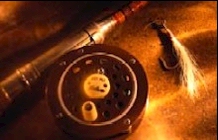|
Fishing Montana's Flathead River - Middle Fork |
|
Information provided by
National Forest Service |
| |
The Middle Fork of the Flathead River
originates in the Bob Marshall Wilderness at the
confluence of Strawberry and Bowl creeks. The upper 46 miles from its start to the
confluence with Bear Creek is designated as “wild” while
the lower 49 miles to the confluence with the North Fork
is designated as “recreational”. Rapids with names such
as “Jaws” and “Bone-crusher” provide sheer exhilaration.
While in the more melancholic sections, it’s easy to get
lost in the rhythm of the river as you breathe in the
splendor of the scenery and the wildlife. Harlequin
ducks, a spring and summer visitor to our country from
the Pacific Coast, can often be seen along the river as
they search for breeding sites.
Fish in the Middle Fork run on the small size (8-12”)
because when the parent rock, argillite, breaks down it
doesn’t contain much of the big fish producing nutrients
that can be found in the productive limestone waters
elsewhere in Montana. Secondly, these waters are cold,
being fed by groundwater and glacier fed streams.
However if you time your trip right, before spring
runoff, you can catch larger westslope cutthroat trout
that migrate from Flathead Lake on their spring spawning
runs. Westslope cutthroat trout and bull trout in the
Flathead River basin are adfluvial, that is they spend
time in Flathead Lake rearing to adulthood until its
time to spawn. Once they are sexually mature (4-6 years)
they migrate into tributary streams, some migrations are
over 100 miles, to spawn (cutthroat in the spring and
bull trout in the fall). Once the fry emerge from the
gravels, juveniles will rear in these tributaries for
1-3 years until they migrate back to Flathead Lake.
Adfluvial
bull trout and westslope cutthroat from Flathead Lake
have declined due to changes in the lakes food web.
Opossum shrimp, mysis relicta, were planted in upstream
lakes in 1967 and 1968. They drifted down rivers into
Flathead Lake becoming established in the late 1970’s
and peaking in the mid 1980’s. Mysis consumed the
majority of zooplankton, thereby causing non-native
kokanee salmon populations to crash due to starvation.
Other fish, such as non-native lake trout and lake
whitefish thrived in these conditions to the detriment
of native fish. The food web in Flathead Lake is most
likely still changing and it is difficult to predict
what the outcome may be. A management plan for the lake
and upper river system is in the works.
Species Present: Westslope Cutthroat Trout, Bull Trout, and Mountain
Whitefish. Non-native Rainbow Trout are becoming
increasingly common in the lower section of the river.
Seasons: Opening is the
third Saturday in May through November 30, however,
there is an extended catch and release season for trout
and a 50 daily limit for whitefish for the rest of the
year. The river is catch and release for cutthroat
trout and a daily limit of 2 for rainbow trout. An
angler needs to check the regulations as many tributary
streams are closed to fishing to protect spawning bull
trout and cutthroat trout. Note: It is illegal to take
or intentionally fish for bull trout.
The best whitewater action can be found during and just
after run-off in June and July. Fishing typically picks
up in late July through September.
Access: Blankenship
Bridge is your first access at the confluence of the
North Fork Flathead River, followed upriver by: West
Glacier, Moccasin, Cascadilla, Paola, Essex, and Bear
Creek. Highway 2 provides excellent access along the
lower river. For the more adventurous, an active
airstrip and an administrative guard station can be
found at Shafer Meadows. A backcountry Ranger is there
to assist floaters and anglers. The Big River Trail #
155, (Trailhead is at Bear Creek) is a good starting
point for those on foot or horse. Anglers looking for
less river traffic should avoid the 6 mile section
between Moccasin and West Glacier as this is the most
popular section for whitewater rafting.
Camping: Devil Creek
Campground near Marias pass along Highway 2 is one
choice for camping. This site is administered by the
Hungry Horse Ranger District as well as Zips Cabin that
is a rental cabin available for rent. There are numerous
RV parks around West Glacier and Highway 2 that have
excellent facilities. If you decide to venture into the
wilderness, please practice Leave-No-Trace. There are
some restrictions in the wilderness, for example, party
size needs to be less than 15 and no stock should be
within 200’ of lakes. Please check on restrictions at
the nearest Ranger District before venturing forth.
|
|
|
|
|
|





